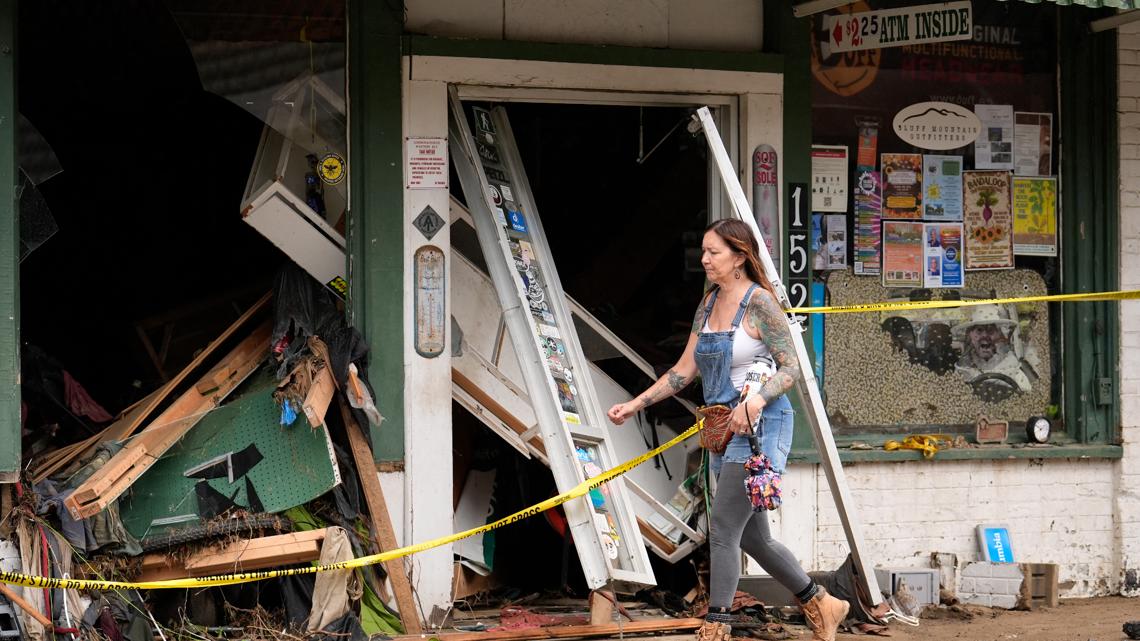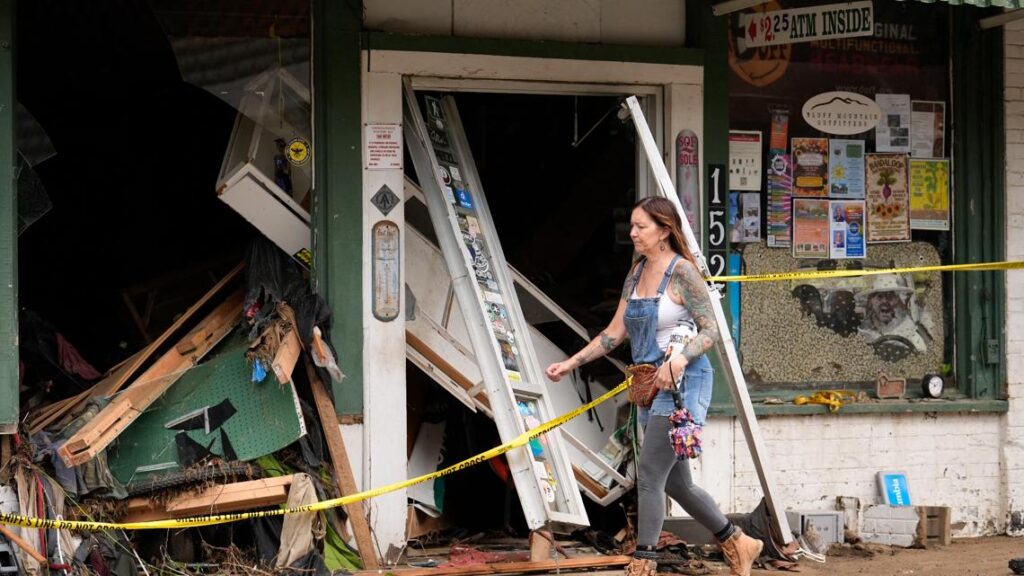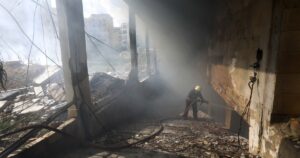
Exhausted emergency crews continue to work around the clock to clear roads, restore power and phone service, and reach those still stranded by the storm.
SWANNANOA, N.C. — President Joe Biden will survey the devastation in North and South Carolina on Wednesday as rescuers continue their search for anyone still unaccounted for after Hurricane Helene caused catastrophic damage across the Southeast and killed at least 166 people.
Many residents in both states were still without running water, cellular service and electricity as floodwaters receded and revealed more of the death and destruction left in Helene’s path.
“We have to jump start this recovery process,” Biden said Tuesday, estimating it will cost billions. “People are scared to death. This is urgent.”
While Biden is in the Carolinas, Vice President Kamala Harris will be in neighboring Georgia.
Helene, one of the deadliest storms in recent U.S. history, knocked out power and cellular service for millions. More than 1.2 million customers still were in the dark early Wednesday in the Carolinas and Georgia. Some residents cooked food on charcoal grills or hiked to high ground in the hopes of finding a signal to let loved ones know they are alive.
On Tuesday, cadaver dogs and search crews trudged through knee-deep muck and debris in the mountains of western North Carolina looking for more victims. At least 57 people were killed in Buncombe County alone, home to city of Asheville, a tourism haven known for its art galleries, breweries and outdoor activities.
In Swannanoa, a small community outside Asheville, receding floodwaters revealed cars stacked on top of others and trailer homes that had floated away during the storm. Roads were caked with mud and debris and pockmarked by sinkholes.
Cliff Stewart survived two feet of water that poured into his home, topping the wheels on his wheelchair and sending his medicine bottles floating from room to room. Left without electricity and reliant on food drop-offs from friends, he has refused offers to help him leave.
“Where am I going to go?” the Marine Corps veteran said. “This is all I’ve got. I just don’t want to give it up, because what am I going to do? Be homeless? I’d rather die right here than live homeless.”
“Communities were wiped off the map,” North Carolina Gov. Roy Cooper said at a news conference.
Across the border in East Tennessee, a caravan including Gov. Bill Lee surveying damage outside the town of Erwin drove by a crew pulling two bodies from the wreckage, a grim reminder that the rescue and recovery operations are still very much ongoing and the death toll is likely to rise.
In Augusta, Georgia, Sherry Brown was converting power from the alternator of her car to keep her refrigerator running. She has been taking “bird baths” with water collected in coolers. In another part of the city, people waited in line more than three hours to get water from one of five centers set up to serve more than 200,000 people.
What is being done to help?
Exhausted emergency crews worked around the clock to clear roads, restore power and phone service, and reach those still stranded by the storm, which killed at least 166 people in six states, including many who were hit by falling trees or trapped in flooded cars and homes. Nearly half of the deaths were in North Carolina, while dozens of others were in South Carolina and Georgia.
More than 150,000 households have registered for assistance with the Federal Emergency Management Agency, and that number is expected to rise rapidly in the coming days, said Frank Matranga, an agency representative.
Nearly 2 million ready-to-eat meals and more than a million liters of water have been sent to the hardest-hit areas, he said.
The storm unleashed the worst flooding in a century in North Carolina, dumping more than 2 feet (61 centimeters) of rain in places.
Cooper’s administration said Tuesday that more than two dozen water plants remained closed. Active-duty U.S. military units may be needed to assist the long-term recovery, he said, adding that Biden had given “the green light” to mobilizing military assets soon.
A section of one of the region’s main arteries, Interstate 40, reopened Tuesday after a mudslide was cleared, but a collapsed stretch near North Carolina’s border with Tennessee remained closed.
How some of the hardest-hit areas are coping
Residents and business owners wore masks and gloves while clearing debris Tuesday in Hot Springs, North Carolina, where almost every building along the tiny town’s main street was heavily damaged.
Sarah Calloway, who owns the deli and gourmet grocery Vaste Riviere Provisions, said the storm arrived in town frighteningly quickly. She helped fill sandbags the day the night before, but they turned out to be useless. The water rose so rapidly that even though she and others were in an apartment on an upper floor, she feared they would not be safe. They called to request a rescue from a swift water team.
“They tried to get to us, and at that point they couldn’t,” she said. “Luckily, that was when the water started to recede.”
“It was really challenging to watch how quickly it rose up and then just to watch whole buildings floating down the river. It was something I can’t even describe,” she said.
In the Black Mountain Mobile Home Park in Swannanoa on Tuesday, Carina Ramos and Ezekiel Bianchi were overwhelmed by the damage. The couple, their children and dog fled in the predawn darkness on Friday as the Swannanoa River’s rapidly rising waters began flooding the bottom end of the park.
By then, trees were blocking the roads and the couple abandoned their three vehicles, all of which flooded.
“We left everything because we were panicking,” Ramos said.
Their children were staying with Ramos’ parents and did not want to even see the devastated trailer.
“My daughter was crying, panicking,” Ramos said. “She says she doesn’t want to see her room full of toys, all thrown everywhere.”
Mobile service knocked out
The widespread damage and outages affecting communications infrastructure left many people without stable access to the internet and cellular service.
Mayor Zeb Smathers of Canton, North Carolina, expressed frustration Tuesday that so many of his constituents were still without cell service and given no clear timetable for when it would be restored.
“People are walking the streets of Canton with their phones up in the air trying to catch a cellphone signal like it’s a butterfly,” he told The Associated Press. “Every single aspect of this response has been extremely crippled by lack of cellphone communication. The one time we absolutely needed our cellphones to work they failed.”
Teams from Verizon were working to repair downed cell towers, damaged fiber cables and provide alternative forms of connectivity across the region, the company said in a statement.
AT&T, meanwhile, said it launched “one of the largest mobilizations of our disaster recovery assets for emergency connectivity support.”
The efforts to restore service was made more challenging by the region’s terrain and spread-out population, said David Zumwalt, president and CEO of the Association for Broadband Without Boundaries.
Destruction from Florida to Virginia
Helene blew ashore in Florida late Thursday as a Category 4 hurricane and upended life throughout the Southeast, where deaths were also reported in Florida, Tennessee and Virginia.
Across Georgia, Helene’s inland path knocked out power and shattered lives from Valdosta to Augusta, where a line of cars waiting to get water Tuesday stretched at least a half-mile (0.8 kilometers) down the road.
“It’s been rough,” said Kristie Nelson, who had no idea when her electricity would be restored. “I’m just dying for a hot shower.”
With at least 36 killed in South Carolina, Helene passed the 35 people who were killed in the state after Hurricane Hugo made landfall north of Charleston in 1989.
When Tennessee Gov. Lee flew to the eastern part of the state to survey damage on Tuesday, residents said the governor and his entourage were the first help they had seen since the storm hit.
“Where has everyone been?” one frustrated local asked. “We have been here alone.”
Kruesi reported from Hampton, Tennessee. Contributing to this report were Associated Press journalists Gary D. Robertson in Raleigh; Jeffrey Collins in Augusta, Georgia; John Raby in Charleston, West Virginia; Rebecca Santana in New Orleans; Shawn Chen in New York; Colleen Long in Washington and John Seewer in Toledo, Ohio.











More Stories
Man killed in northeast Denver shooting
Doctor charged in connection with Matthew Perry’s death is expected to plead guilty
Hezbollah battles Israeli soldiers in southern Lebanon